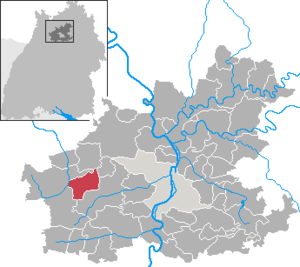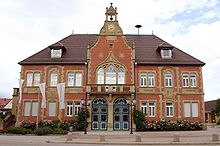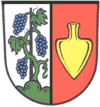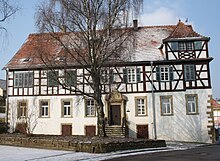Gemmingen
| coat of arms | Germany map | |
|---|---|---|

|
Coordinates: 49 ° 9 ' N , 8 ° 59' E |
|
| Basic data | ||
| State : | Baden-Württemberg | |
| Administrative region : | Stuttgart | |
| County : | Heilbronn | |
| Height : | 212 m above sea level NHN | |
| Area : | 19.08 km 2 | |
| Residents: | 5145 (Dec. 31, 2018) | |
| Population density : | 270 inhabitants per km 2 | |
| Postal code : | 75050 | |
| Area code : | 07267 | |
| License plate : | HN | |
| Community key : | 08 1 25 034 | |
| LOCODE : | DE GMG | |
| Community structure: | 2 districts | |
| Address of the municipal administration: |
Hausener Strasse 1 75050 Gemmingen |
|
| Website : | ||
| Mayor : | Timo Wolf | |
| Location of the municipality of Gemmingen in the Heilbronn district | ||
Gemmingen is a municipality in the Heilbronn district in Baden-Württemberg . It belongs to the Heilbronn-Franconia region (until May 20, 2003 Franconia region ).
geography
Geographical location
Gemmingen is located in the northeastern Kraichgau , in the west of the Heilbronn district.
Neighboring communities
Neighboring towns and communities in Gemmingen are ( clockwise , starting in the west) the town of Eppingen , the communities of Kirchardt and Massenbachhausen and the town of Schwaigern (all districts of Heilbronn). With Eppingen and Ittlingen , Gemmingen has become the Eppingen-Gemmingen-Ittlingen administrative community .
Community structure
Gemmingen consists of Gemmingen itself and the district of Stebbach . The Eichmühle residential area still belongs to Gemmingen, the Schomberg palace and courtyard belong to Stebbach , the Streichenberg courtyard and residential area (former castle) and the Stebbach residential area (train station). The Outbound, defunct so today place rooms was on district Stebbach.
The municipality of Gemmingen has (mid-2006) 4971 inhabitants, of which 3517 live in the Gemmingen district and 1454 in the Stebbach district.
Division of space

According to data from the State Statistical Office , as of 2014.
history
Until the 18th century
It is assumed that the place in the Staudbachtal goes back to a Roman settlement, which was taken over by the Alamanni in the 3rd century and named after their tribal prince Gemmo. Gemmingen (former names: Gemminchheim, Gemmininchheim or Gemyngen) was first mentioned in the Lorsch Codex in 769 on the occasion of the oldest of around 20 donations to the Lorsch Monastery . Today's deserted rooms and the town of Stebbach , which was first mentioned in 1292, are probably expansion settlements from Gemmingen from the younger Merovingian period around the 8th century. Gemmingen was first included in the Gartachgau , later in the Kraichgau . During the time of the tribal duchies, the place was in the Duchy of Franconia .
In 1235, Hans von Gemmingen, the imperial bailiff in Sinsheim , was the first to mention the lords of Gemmingen , who may have been wealthy in the village for a long time. They built three castles in the village in the 13th century: The middle castle is already owned by Hans von Gemmingen in 1235, was destroyed in the Thirty Years War and not rebuilt, the rent office was later built in its place . The upper castle was built around the middle of the 13th century and was no longer inhabited and sold by the von Gemmingen family after 1630. The Gemmingen lower castle, which has been preserved to this day, goes back to the moated castle built around 1274 by Schweiker, known as the Velscher . The castle was rebuilt several times and the moats were later filled. The Velscher family line died out with Hans in 1552. This handed over the lower castle in 1550 to Wolf von Gemmingen († 1555). His grandson Wolf Dietrich (1550–1595) had it renewed in 1592 in the Renaissance style.
A fourth early mansion in the immediate vicinity is the Streichenberg Castle in the district ofzimmer , which was also owned by the Lords of Gemmingen in the high Middle Ages, but had a changing history of ownership as early as the 14th century. The lords of Gemmingen owned Gemmingen, Stebbach and rooms in varying proportions as allodial property or fiefdom . From the late 15th century they received numerous other possessions, in particular fiefs from the Electoral Palatinate . In 1508, Uriel von Gemmingen from the Gemmingen-Michelfeld line was Archbishop of Mainz and German Arch Chancellor. The various branches of the widespread family produced numerous other high dignitaries.
The place Gemmingen counted as an imperial knighthood place to the knight canton Kraichgau , while Stebbach and Streichenberg came to the Electoral Palatinate. In 1497, the lords of Gemmingen acquired the highest jurisdiction at their headquarters in Gemmingen . The local lord Wolf von Gemmingen († 1555) founded the Gemmingen Latin School in 1521 and was an early supporter of Luther and promoter of the Reformation , which he carried out permanently in Gemmingen, while Streichenberg and Stebbach were affected by frequent changes of denomination in the Electoral Palatinate.
During the Thirty Years' War the place was almost depopulated and after 1648 settled by immigrants from Switzerland and France who had to do multiple reconstruction work after the devastation of the Palatinate War of Succession raging from 1688 to 1697 .
In 1664 the lords of Gemmingen sold the upper castle and part of the town to Württemberg . This share went to the Lords of Neipperg in 1710 . Stebbach, on the other hand, came from the Palatinate to the Raugräfin Marie Luise and in 1733 to the Counts of Degenfeld-Schonburg .
19th and 20th centuries
As a result of the mediatization of the imperial knighthood, Gemmingen came to the Grand Duchy of Baden in 1806 . Stebbach came to the Principality of Leiningen at the end of the Electoral Palatinate in 1803 , but after its rapid end in 1806 it also became Baden.
The construction of the Kraichgau Railway in the years before 1880 brought Gemmingen a certain degree of prosperity, while Stebbach had a declining population due to emigration and rural exodus at the same time. On the night of July 1, 1897, the places were affected by a severe thunderstorm and hail catastrophe. Both places were electrified in 1920. In 1939, 1,170 inhabitants were counted, at the end of 1945 there were 1,360. The central water supply for Gemmingen and Stebbach was installed in 1952.
On January 1, 1925, the district of Streichenberg with Streichenberg Castle and the Schomberg Castle, built in the 19th century, were incorporated into Stebbach. On January 1, 1974, the previously independent community of Stebbach was incorporated into Gemmingen. The incorporation was decided by a large majority after the independent continued existence of both communities was seriously endangered by resolutions of the state government to reform the community in the early 1970s.
Religions
As early as the beginning of the 1520s, Wolf von Gemmingen († 1555) and Bernhard Griebler, the owner of the Gemminger predicature , were supporters of Luther. At the end of 1531 or beginning of 1532, Wolf appointed a Lutheran pastor after the pastor, who held fast to the old faith, had given up and left Gemmingen. After years of dispute with the patron saint of the parish, the cathedral chapter in Speyer, the reformatory movement in Gemmingen had prevailed. In Stebbach, however, based on the principle of cuius regio - eius religio, the denomination of the residents changed ten times between 1545 and 1648. In 1649, Stebbach was finally reformed with the Palatinate Electors . In Gemmingen today there is a Protestant and an Evangelical Free Church ( Baptist ) community. The Roman Catholic Christians are looked after by the Catholic parish in Eppingen.
There were a few Jews living in Gemmingen as early as the 17th century, but through a targeted settlement policy from 1710 onwards, the Jewish community of Gemmingen was first formed in the Gemmingen part of the village, which was allowed a Jewish school ( synagogue ) from 1727 and 12 families, 1762 already comprised 17 families with around 100 people. From 1790, the Counts of Neipperg also took Jews into Gemmingen. In 1809 the community consisted of 16 families with a total of 86 people and continued to grow until the middle of the 19th century (1864: 291 people), but then decreased due to emigration and emigration. Between 1900 and 1933 the size of the community decreased from 157 to 47 people. After 1933, most of the Jews in Gemmingen emigrated or moved to larger cities. In 1938 the synagogue was demolished and then acquired by the Gemmingen community. The last seven Jews in Gemmingen were deported to the Gurs internment camp in 1940, three of them subsequently perished in Auschwitz . Also in the district of Stebbach there was a temporarily important Jewish community, the Jewish community of Stebbach , from the 18th century .
Denomination statistics
In 2000 there were 2567 Protestants (51.4%) and 1315 Catholics (26.3%) in the entire community. The remaining 1,115 people (22.3%) included a large number of Muslim believers. According to the data of the 2011 census, there were 2373 Protestants (48.1%), 1158 Catholics (23.5%) and 1405 non-denominational people and members of other religions (28.5%) in Gemmingen . According to the data of the community (as of June 5, 2019) there are currently 2,195 (42.6%) Protestants, 1,088 (21.1%) Catholics and 1,865 (37.3%) non-denominational in Gemmingen and members of other religions.
politics
Municipal council
In Gemmingen the municipal council is elected according to the procedure of the false sub-district selection. The number of local councils can change due to overhang mandates . The municipal council in Gemmingen has 16 members after the last election (2009: 17). The local elections on May 25, 2014 led to the following official final result:
- CDU: 5 seats
- SPD: 4 seats
- FWV: 4 seats
- LDN: 3 seats.
The municipal council consists of the elected voluntary councilors and the mayor as chairman. The mayor is entitled to vote in the municipal council.
Result of the local elections on June 7, 2009:
- CDU 29.6% (- 1.3) - 5 seats (=)
- SPD 27.9% (- 1.5) - 5 seats (=)
- FWV 22.4% (- 1.5) - 4 seats (+ 1)
- List Village and Nature (LDN) 20.1% (+ 4.2) - 3 seats (+ 1)
mayor
Timo Wolf has been the mayor since 2001 and was confirmed in office in 2009 and 2017.
badges and flags
The blazon of the Gemmingen coat of arms reads: In a split shield in front in silver on a green three-hill on a black pole, a green vine with three blue grapes, in the back a golden ploughshare in red. The flag of the municipality is yellow and red.
The heraldic figures of the vine and the ploughshare , which indicate agriculture and viticulture , have been documented in Gemminger Siegeln since the 19th century . The colors of the coat of arms were determined by the General State Archives in 1901 , and the Gemmingen municipal council approved them “once and for all” in 1910. The flag was awarded to the community on May 2, 1969 by the Baden-Württemberg Ministry of the Interior.
Partner municipality
The partner municipality Gemmingens has been the municipality of Dunavarsány in Hungary since June 5, 1999 . The partnership goes back to 1996 when a Hungarian tour group discovered Gemmingen by chance.
Culture and sights
Buildings
- In the middle of the village is the three-story Gemmingen Lower Castle , the manor house of the von Gemmingen family . The building was probably erected in 1592 on the foundations of the Lower Castle, which was built around 1274. Next to the castle is a medieval defense tower. The castle has a magnificent Renaissance portal, on the castle wall there are numerous historical grave slabs of the Lords of Gemmingen, which were moved there from the old church in the 19th century when the new church was built. The adjacent large castle park was acquired by the municipality and laid out in its present form from 1982 to 1988.
- The former rent office (expanded in 1717) and the old fruit store (built in 1743 over the older core) are two half-timbered buildings from the early 18th century and were formerly part of a manorial courtyard.
- The Gemmingen town hall , built in 1902–03 in the eclectic style with rich architectural decorations, was once also a post office and syringe house. It was built on the site of the former Upper Castle as a necessary replacement for the too small historic town hall from 1752, which is also still preserved. The town hall was completely renovated in the 1990s and expanded with a nearby new building.
- The Protestant church is a new building from 1846/47 on the site of the old Gemminger church. Pleikard von Gemmingen († 1515) had a new east-facing nave and a new vestibule built in the late 15th century for the then St. Martini Church. The new construction of the tower, which had begun under him, was completed in 1516 by his son Wolf. From this old church only the 33 meter high tower with vestibule is preserved today. Today's north-facing nave of the hall church was built from sandstone in 1846/47 . On the long sides of the nave, stone galleries are drawn in, which rest on stone pillars, so that the inside gives the impression of a basilica . On the south wall there is a wooden pulpit, above it a Gothic tracery window . An altar cross from 1500, attributed to Hans Seyfer , is kept in a wall niche . The other furnishings of the church come from modern times, including the coats of arms of the windows from 1947, which are stained glass. The evangelical rectory belonging to the church was built around 1725.
- The Catholic Church of St. Mary and its parsonage was built in 1953 in the simple design language of the time at the southern entrance to the town. In 1963 the original roof turret of the church was removed and a free-standing bell tower ( campanile ) was built instead .
- There are numerous other historical buildings of architectural interest in the village, including other half-timbered buildings, shops from the 19th century, settler houses from the 1930s and the old Latin school that Wolf von Gemmingen founded in 1521.
Parks
The castle park, which was acquired by the municipality and redesigned from 1982 to 1988 in the style of an English landscape park, is attached to the Gemminger Castle . There is a war memorial, a stately gardener's house, historical waymarks ( milestones ).
sport and freetime
The Gemmingen open-air swimming pool, which has been in existence since 1977, has been called the Imre-Gutyan open-air swimming pool since it reopened after being renovated in 2015 . It was named after the local swimming master and swimming sports official Imre Gutyan, who had fled to the West as a member of the Hungarian Olympic team in 1964 and was most recently referee chairman at the Württemberg Swimming Association.
Economy and Infrastructure
Gemmingen is a wine-growing town whose location Sonnenberg belongs to the Heuchelberg area in the Württemberg lowlands of the Württemberg wine-growing region .
The Wüteria mineral springs filled into Gemmingen since 1928 mineral water and soft drinks. The company employs 33 people (as of 2012) on site.
traffic
Street
Gemmingen is on the B 293 from Heilbronn to Karlsruhe . The next junctions of the A 6 ( Saarbrücken - Waidhaus ) are about 12 kilometers away.
rail
Gemmingen is on the Kraichgaubahn ( Heilbronn - Karlsruhe ), which is used by the Karlsruhe Stadtbahn. In the city there are the Gemmingen and Gemmingen West stops. There is a 30-minute cycle to Karlsruhe and Heilbronn, every second train is an express train and does not stop everywhere. The district of Stebbach used to be connected to the rail network via the Steinsfurt – Eppingen railway line, but the stop has now been abandoned.
media
The daily newspaper Kraichgau Stimm, a subsidiary edition of Heilbronner Voice , and the Heidelberger Rhein-Neckar-Zeitung report on the events in Gemmingen . The municipal administration publishes the official gazette for the municipality of Gemmingen with the district of Stebbach .
education
The Wolf-von-Gemmingen-Schule (elementary and secondary school ) sees itself as a job - oriented all-day school and is attended by 380 students. The elementary school in Stebbach with 90 students is organizationally affiliated to it . There are also three kindergartens in the village, one of which is in the Stebbach district.
The Gemmingen community library, which opened in April 2000, can be used by anyone free of charge.
Personalities
Honorary citizen
- Hugo Richheimer, Director of the Schaumweinvertriebs AG in Frankfurt am Main
Sons and daughters of the church
- Dietrich von Gemmingen (1584–1659), knight captain
- Bernhard Kahn (1827–1905), industrialist and banker in Mannheim
- Aaron Kahn (1841–1926), industrialist in Augsburg
- Hermann Schäufele (1906–1977), Archbishop of Freiburg
People who worked on site
- Udo Pollmer (* 1954), food scientist and book author, lives in Gemmingen
- Alper Balaban (1987-2010), soccer player, grew up in Gemmingen
literature
- Ulrich Kopp: The Kraichgaugemeinde Gemmingen. A description of the place at the turn of the millennium . Gemmingen community, Gemmingen 2000, ISBN 3-00-007335-3
- Tony Fleck: Gemmingen 769-1969. 1200 years of current affairs . Gemmingen community, Gemmingen 1969
Web links
References and comments
- ↑ State Statistical Office Baden-Württemberg - Population by nationality and gender on December 31, 2018 (CSV file) ( help on this ).
-
^ Source for the section on community structure:
Das Land Baden-Württemberg. Official description by district and municipality. Volume IV: Stuttgart district, Franconian and East Württemberg regional associations. Kohlhammer, Stuttgart 1980, ISBN 3-17-005708-1 . Pp. 75-77 - ↑ Source: Gemmingen in numbers on gemmingen4u.de, as of June 30, 2006, accessed on December 23, 2007
- ↑ State Statistical Office, area since 1988 according to actual use for Gemmingen.
- ↑ Minst, Karl Josef [transl.]: Lorscher Codex (Volume 4), Certificate 2533, December 24, 769 - Reg. 467. In: Heidelberg historical stocks - digital. Heidelberg University Library, p. 163 , accessed on March 5, 2016 .
- ↑ List of places for the Lorsch Codex, Gemmingen , Archivum Laureshamense - digital, Heidelberg University Library.
- ↑ Communications from the Württ. And Bad. State Statistical Office No. 2: Results of the population census on December 31, 1945 in North Baden
- ^ Federal Statistical Office (ed.): Historical municipality directory for the Federal Republic of Germany. Name, border and key number changes in municipalities, counties and administrative districts from May 27, 1970 to December 31, 1982 . W. Kohlhammer, Stuttgart / Mainz 1983, ISBN 3-17-003263-1 , p. 465 .
- ^ Gustav Bossert: Contributions to the Baden-Palatinate Reformation history . In: ZGO 58 (1904), p. 30.
- ↑ Gerhard Kiesow: From knights and preachers. The Lords of Gemmingen and the Reformation in Kraichgau . regional culture publisher, Ubstadt-Weiher 1997 p. 73f.
- ↑ Kopp 2000, pp. 31/32.
- ↑ https://results.zensus2011.de/#dynTable:statUnit=PERSON;absRel=PROZENT;ags=081255004034;agsAxis=X;yAxis=RELIGION_KURZ Gemmingen
- ↑ Gemmingen Figures, Data, Facts, Statistics , accessed on February 6, 2020
- ↑ http://www.gemmingen.eu/de/unsere-gemeinde/gemeinderat/lösungen.html
- ↑ http://www.rnz.de/nachrichten/sinsheim_artikel,-Buergermeisterwahl-Timo-Wolf-tritt-in-Gemmingen-erneut-an-_arid,265428.html
-
↑ Source for the section coat of arms and flag:
Heinz Bardua: The district and community coat of arms in the Stuttgart administrative region . Theiss, Stuttgart 1987, ISBN 3-8062-0801-8 (district and municipality coat of arms in Baden-Württemberg, 1). P. 68 - ↑ Adolf von Oechelhaeuser (arrangement): Die Kunstdenkmäler des Großherzogtums Baden , Vol. 8,1, Tübingen 1909. P. 169. Oechelhäuser puts the beginning of the new nave construction under Pleikard at 1457, but he was born around 1440 and was young Years still canons in Wimpfen, cf. Carl Wilhelm Friedrich Ludwig Stocker: Family chronicle of the barons of Gemmingen , Heidelberg 1895.
- ↑ http://www.wf-gemmingen.de/aktuell.htm














